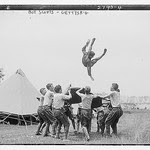By Kristin Johnstad, Johnstad and Associates, LLC
In supporting the growth of intentional community action networks, one of my favorite skillset to cultivate is coaching. Here are two coaching frameworks and practices that I use and have found highly effective in helping people to help one another.
Our goal is to work in new, networked ways and address complex community issues together, so without a doubt, we will get tossed around and need peers and even trusted confidantes to stay in the game (and even have fun override waves of fear or panic).
My “go-to” solution is to create a peer support mechanism to bring people together simply and effectively for advice, resources, or coaching.
Some leadership folks will want individual coaching, but this can be expensive and doesn’t make use of one of the benefits of networks — access to the intelligence of others! Peer support or coaching processes also grow our skills by putting them to good use. There are many models of peer support groups. One I’ve used since 2005 is Authenticity Circles developed by Carter McNamara.
The process of peer support looks like this:
- each person in the group gets time to explain a challenge or issue (as the focal person)
- others in the group ask probing questions that help the person better understand the challenge
- others offer advice or resources depending on what the focal person wants from peers
- the focal person summarizes new insights they have gotten
- the focal person describes a next step they will take to address the challenge
At the end of the support session, the entire group reflects on what they have learned, new insight they have gained. The next time the peer group gathers each individual reports on the outcomes of the action they took during the intervening month and what they are learning.
Peer support groups can be virtual or face-to-face. However, I’ve found that it is good for people to meet face-to-face for the first session, if possible, and have a chance to get to know each other as people (their likes, dislikes, interests, passions, family, etc). If this is not possible, I find it useful to use a platform where people can see each others’ faces. Common ones that I have used are Zoom, Google Hangout or Microsoft teams.
It’s useful to set up a block of sessions (once a month for six months) and then at the end of this period determine whether the group wants to continue. It often helps, especially for groups where people are not familiar with peer support, to have a facilitator who moves the process along. This facilitator might also be the one who sets up the times for the sessions and sends out reminders.
It’s also helpful to have everyone agree to a set of ground rules such as:
· I agree to participate regularly in this group
· I agree to prepare ahead of time so my challenge is well-defined
· I agree to keep whatever is said in the session confidential
· I agree to follow through on the action step I identify
In addition, the facilitator can model the use of good coaching questions:
· What about this challenge has surprised you?
· If you did this over again, how might you do it differently?
· Have you ever experienced anything like this before? How did you deal with that situation?
· Is there anyone in your project network who could be a support to you in this?
· What would be good to clarify before you move forward?
· What are a number of options for your next steps?
· What are your thoughts about a possible next step? Why that step?
· What are some resources you might explore?
· What assumptions were you making? Have they been challenged?
· What would success look like to you?
A facilitator can focus the exchange of resources or advice-giving in ways that are efficient and radically useful. All people need is enough insight to get unstuck or see something with fresh eyes. Keeping the peer exchanges focused makes good use of limited time and surfaces potential conversations that can be explored in twosies or one-on-ones as a follow to the format circle time.
The other peer consultation model I am exploring is Troika Consulting. This peer-based support model grows skills in listening and asking for help. People have to practice framing complex issues clearly and succinctly as well as be open to input and feedback.
I believe if you give generously and hold your expertise “lightly” in a mutual support or aid process the result will cultivate mutual respect and trusting relationships. I will use Troika Consulting for the next six months as an add-on to an existing “lunch and learn” monthly meeting. Any network weavers who want to stay another 30 minutes will get to present a current challenge and consult on at least 2 others issues offered by colleagues. Fingers crossed it will be a fun and efficient way to get practical and imaginative support from peers.
What has been your experience in setting up peer support or coaching groups? Have you applied that to helping weavers provide leadership to influence positive community change?
Add your comments and ideas below.
Note: This blog was inspired by my 2012 work with June Holley who continued to be a light in my life and inspiration in the world. Check out network weaver.
